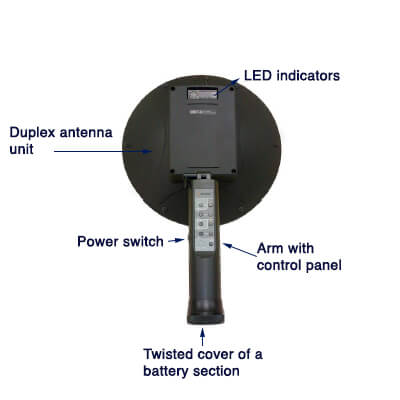The devices operation functions on the principles of semiconductor components, so to generate a response in second and third harmonics when they are radiated by a UHF signal.
If the semiconductor components are of artificial origin, they will have a higher level of second harmonic. To the contrary, semiconductor components of natural origin, such as oxide films, will have a higher level of third harmonics.
The NLJD 36 from Lornet, uses the second and third harmonics response of the radiated objects as to enable a fast and accurate identification of electronic devices and natural oxide semiconductors. It even works in challenging electromagnetic environments, as the digital processing of the demodulated signal provides max. sensitivity.
It has two types of radiated signals: the pulse modulated carrier with a duty cycle of 0.4% (pulse), and, the pulse modulated carrier with a duty cycle of 6% (CW).
Furthermore, the Lornet 36 - Non-Linear Junction Detector comes with the following advantages:
- Built in loudspeakers and wireless earphones - enable the detection of working analog microphones (due to acoustic bonding)
- The Laser lightning of the center of directivity diagram lets you perform spacial operations with a clear focus
- The LED panel, and the option to reproduce the estimated harmonics levels aurally, makes the work user friendly
Lornet 36 Main Features:
- Allows operational and investigational activities in location with high density of people containing electronic devices
- Allows the search of small electronic devices from 1-2 cm
- Detects SIM cards at a 1m distance
- SHF range allows the detection of semiconductor elements hidden in unusual places like; underneath screens, in cracks, under reflective smooth surfaces, etc.
- The devices frequency does not overlap with cellular phones - 3580-3620 MHz
- Automatic or manual power control
- Wireless earphones
- Ease of operation and light weight
- Very low electromagnetic influence on the user
Lornet-36 Basic Specifications:
Type of probing signal: pulse
Probing signal frequency: 3580-3620 MHz
Receiver frequency at 2nd harmonics: 7160-7240 MHz
Receiver frequency at 3rd harmonics: 10740-10860 MHz
Antenna gain factor at 1st harmonics: 20 dB
Antenna gain factor at 2nd harmonics: 24 dB
Capacity (pulse ratio) of pulse signal: 20 W (160)
Energy potential (capacity of probing signal taking into account antenna gain factor): 2000 W
Sensitivity at 2nd and 3rd harmonics (without antenna gain): minus 110 dBm
Dynamic range: More than 40 dB
Angle of antenna directivity diagram (at 1st//2nd//3rd harmonics): 16//8//4 grade
Laser lightning of the center of directivity diagram: yes
Time of work from built-in accumulator at max. capacity of probing signal: 3h
Weight max. 1.4 kg
Dimensions:
- In working conditions: 47,7*30,3*22,7cm
- Transportable conditions: 30,3*30,3*23cm
Lornet-36 Full Specifications:
Types of radiated signals:
- pulse modulated carrier with a duty cycle of 0.6% (Pulse)
- pulse modulated carrier with a duty cycle of 5.0% (CW)
Fixed carrier frequency - step 13 MHz within range of (3581.5-3607.5) MHz
Automatic frequency selection.
Possibility of radiation at the carrier frequency with a minimum noise level in the 2nd harmonic receiver path
Maximum power with duty cycle of 0.6% (Pulse) min. 18 W.
Maximum power with duty cycle of 5.0% (CW) min. 12 W.
Automatic or manual power control.
Power control range 22 dB from maximum value, divided into 11 level gradations.
Transmittance antenna gain at 3600 MHz – min. 20 dB, beam width by -3 dB level not 3 more than 16 degrees.
Receiver sensitivity better than –110 dBm (the 1st LED lights up).
Receiver's tuning frequencies equal to the transmitter double and triple frequencies, comprising 716-7215 MHz and 10744.5-0822.5 MHz
Receiving path dynamic range – 30 dB (20 dB – LED indicator range, 10 dB – attenuator range at receiver input adjusting by ATT button)
Time of continuous operation with a Lithium-Ion battery at the maximum radiated power not less:
- 3 hours in Pulse mode
- 2 hours in CW mode
Operating conditions:
- ambient temperature - 5-40C
- pressure - 450-800 mm of mercury
Name and parts from User Manual:
Package contents:
- Duplex antenna unit with a control panel and a built-in container for a battery
- Two changeable Li-Ion batteries
- Container for battery charging
- Charger for a duplex unit battery
- Receiver with an adapter to charge its battery and earphones
- User Manual and Certificate
- Package bag to keep and transport the device
Notes
Feel free to study the user manual before use. It is useful to be familiar with the operation, search recommendations and safety measures for the Lornet 36 NLJD offered in the PDF below.

.webp)
